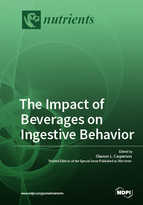The Impact of Beverages on Ingestive Behavior
A special issue of Nutrients (ISSN 2072-6643).
Deadline for manuscript submissions: closed (15 August 2018) | Viewed by 75273
Special Issue Editor
Interests: dietary protein; the role of dietary protein in metabolic health; energy metabolism; eating behaviors; skeletal muscle metabolism; macronutrients and food reinforcement; obesity
Special Issues, Collections and Topics in MDPI journals
Special Issue Information
Dear Colleagues,
Nutrients is planning a Special Issue focusing on beverages and ingestive behavior. This Special Issue will focus on research related to all aspects of beverage consumption and post-ingestive consequences. There continues to be much controversy surrounding the influence of beverage choice on health outcomes. Research investigating the impact of beverage choice has on human health and post-ingestive consequences continue to grow. We know from the growing body of literature that beverage choice has a substantial impact on metabolism, food reinforcement and eating behaviors. This Special Issue will provide an opportunity to publish a collection of new findings to help guide evidence-based decisions.
Potential topics may include, but are not limited to:
- Short-term and long-term intervention trials and epidemiological studies investigating the role of beverages on food intake, eating behaviors and post-ingestive consequences.
- Correlations between beverage consumption, diet quality and nutritional status.
- Beverage consumption patterns and health outcomes
- The timing of beverage consumption on post-ingestive consequences
I invite you to submit your latest research on beverage consumption and ingestive behavior to this Special Issue.
Dr. Shanon L. Casperson
Guest Editor
Manuscript Submission Information
Manuscripts should be submitted online at www.mdpi.com by registering and logging in to this website. Once you are registered, click here to go to the submission form. Manuscripts can be submitted until the deadline. All submissions that pass pre-check are peer-reviewed. Accepted papers will be published continuously in the journal (as soon as accepted) and will be listed together on the special issue website. Research articles, review articles as well as short communications are invited. For planned papers, a title and short abstract (about 100 words) can be sent to the Editorial Office for announcement on this website.
Submitted manuscripts should not have been published previously, nor be under consideration for publication elsewhere (except conference proceedings papers). All manuscripts are thoroughly refereed through a single-blind peer-review process. A guide for authors and other relevant information for submission of manuscripts is available on the Instructions for Authors page. Nutrients is an international peer-reviewed open access semimonthly journal published by MDPI.
Please visit the Instructions for Authors page before submitting a manuscript. The Article Processing Charge (APC) for publication in this open access journal is 2900 CHF (Swiss Francs). Submitted papers should be well formatted and use good English. Authors may use MDPI's English editing service prior to publication or during author revisions.
Keywords
- Beverages
- Sugar-sweetened beverages
- Non-nutritive sweetened beverages
- Diet beverages
- Obesity
- Eating behavior
- Food reinforcement
- Digestion
- Added sugar
- Metabolism
- Body weight
- Food intake
- Human health







